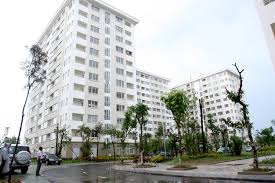
According to the Ministry of Construction of Vietnam, the real estate market maintained a high, stable growth rate in the first 6 months of 2016. Property inventories dropped while outstanding credits for property rose. Hanoi witnessed some 7,800 successful deals while the figure was 7,500 transactions in Ho Chi Minh City. As of June 20, 2016, the total value of real estate inventories was estimated at VND37,489 billion, down VND13,400billion or 25 per cent from December 2015.Meanwhile, in addition to commercial housing, the market has a huge demand for social housing but the current supply is low. The supply is estimated to be short of 7 million square metres of houses in 2020.Only in 2015, the country had 33 social housing projects completed, including 13 projects with 6,164 apartments for low-income people and 20 projects with 8,273 apartments for workers. To date, the country has completed more than 135 social housing projects, including 51 projects with 25,850 apartments for low-income people and 84 projects with 28,550 apartments for workers. Without doubt, social housing has given a facelift to urban areas and provided settling places for thousands of households. Then, controlling the property market provided positive effects, helped economic recovery and eased hardships for related economic sectors.However, after the strong development phase in 2013-2014, the number of new social housing projects declined sharply from the beginning of 2016 because the social housing credit package of VND30,000 billion almost ran out. Besides, preferential policies for rented houses are greater than houses for sale while property companies still ask for changing the purpose of building houses for rent to houses for sale.Recently, at the Vietnam – Singapore Business Forum 2016 (VSBF 2016) held by the Vietnam Chamber of Commerce and Industry (VCCI) in cooperation with the Embassy of Singapore in Vietnam, Dr Truong Anh Tuan, Vice Chairman of the Vietnam Real Estate Association, confirmed that the demand for social housing in Vietnam is huge. Up to 1.74 million people in urban areas and 1.7 million people in industrial parks lack accommodations. The demand for social housing is forecast at 700,000 units.He added that the Government has introduced many special policies to develop this segment to meet the demand. For example, the government has expanded the scope of social housing buyers from six groups to 10 groups. It has also eased borrowing conditions like removing the regulation on income verification, lowering the interest rate from 6 per cent per annum in 2014 to 5 per cent in 2015 and 2016, prolonging the term of preferential interest rates from 10 years to 15 years, and imposing a value added tax of 5 per cent.Besides, the Government encouraged businesses to increase investment for social housing projects like adjusting the upper limit price of VND15 million per square metre, exempting land rents, slashing 50 per cent of VAT and reducing corporate income for social housing investors.In addition, investors will be granted soft loans and interest rate subsidies as well as public utilities.Remarking on prospective opportunities for social housing, Tuan noted that the demand in this segment is very high and government supports are exerting a pull on investors and purchasers. Moreover, modern, environment-friendly expansive urban planning is another factor to assert that social housing will continue to develop and become a trend in the future.According to real estate experts, timely policy supports and instructions from the State Bank of Vietnam (SBV) leveraged social housing. The SBV helped many homebuyers who did not have their loans disbursed from the VND30 trillion credit package before the deadline – June 1, 2016 – to get the rest of their loan values signed before the deadline. Circular No. 25/2016/TT-NHNN of the SBV, which come into effect on August 1, 2016, also helped real estate businesses active in social housing segment. They expected the market will revive as in the previous period.Furthermore, sufficient and timely guidelines on social housing lending have gladdened both property businesses and homebuyers, especially those seeking a settling place for their lives.These developments boosted up the confidence of social housing investors in starting new projects in this segment.

















